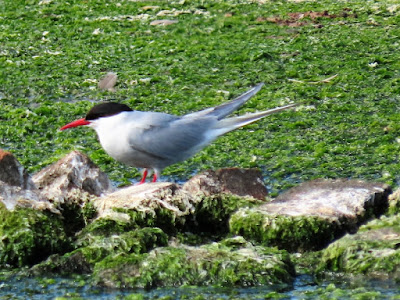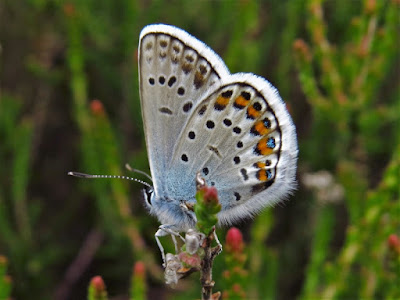Cemlyn Bay
North Wales Wildlife Trust looks after the Cemlyn Bay site which, in summer, is home to breeding Arctic, Common and Sandwich Terns. There were reportedly two Roseate Terns but they eluded me. All the terns breed on and around the islands in the lagoon. The island is protected from ground predators such as foxes by an electric fence. Here is an over view.
The most graceful of the terns are the Arctic Terns. They have a blood-red bill and the longest tail-streamers of the three species seen.
One perched on the ground. The legs of this species are very short.
This one is hovering looking for prey....
...and diving down to spear it.
One returning with a fish.
Very graceful.
This one outbound showing the underwing. On an Arctic Tern there would be only a thin black trailing edge to the primaries – again hard to see without freezing the action with a camera.
Sandwich Terns are the most numerous species with birds constantly passing over the public access beach. Here one is outbound on a fishing expedition.
One returning with a small fish – sand eels are their preferred food.
This bird shows white speckling on the normally all-black cap. Likely this is a first-year bird and it may just be practising rather than nesting.
One with two fish.
This one has three.
A greedy bird with a beakful – five I can see.
A passing bird.
Here with tail spread.
Not too many other birds were in the area. This Little Egret was an exception.
South Stack
Then it was on to the RSPB Reserve at South Stack. The birds are rather more distant here and there was some heat haze making the photos less clear than I would have liked. These are all Guillemots. There is no prize for correctly guessing the number of birds.
A closer view of the crowded ledges on which they lay their single egg.
This gathering of birds is likely birds that have come back full of fish that are waiting for their partner to leave the nest so they take their turn in incubating the egg. How they recognise each other and their few feet of ledge is a mystery.
There are far fewer Razorbills and these tend to be higher on the cliffs. Here are two at the top with Guillemots at the left and bottom left. They can be picked out as they are a jet black whereas the Guillemots are just very dark. With practice they can be separated at long range and you do not need to see the thicker bill with the thin white stripe above it. There did not seem to be any Puffins around – a few breed here each year in burrows in the grassy areas. However access to the island was closed – Covid you know – and the path to there is the best place to find them.
These cliff-nesters are harder to see – a colony of Kittiwakes. They certainly leave a lot of 'splash'! These neat and rather noisy gulls are the most pelagic of the gull species that regularly occur around the UK.
It wouldn't be the seaside without the ubiquitous Herring Gull.
Perhaps this year's highlight was this Chough – a speciality of the area that is rarely as obliging as this.
It not only did a fly-by but then dropped to the ground. The population is being monitored here so all of them have rings.













































